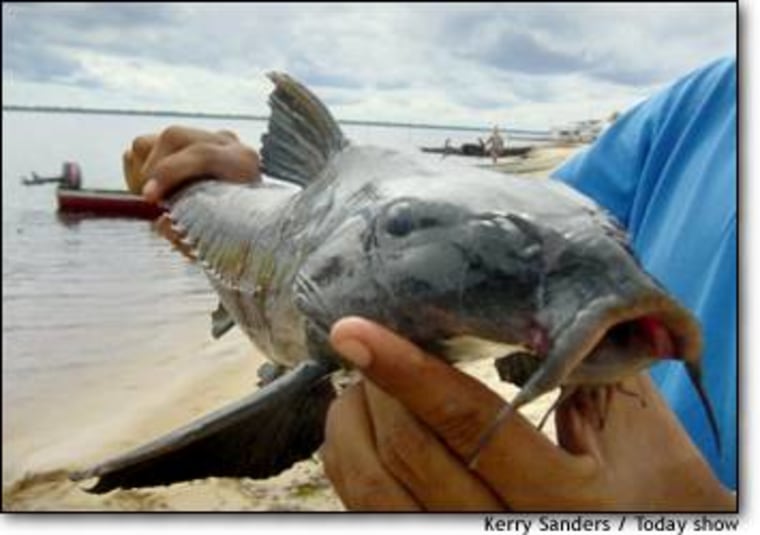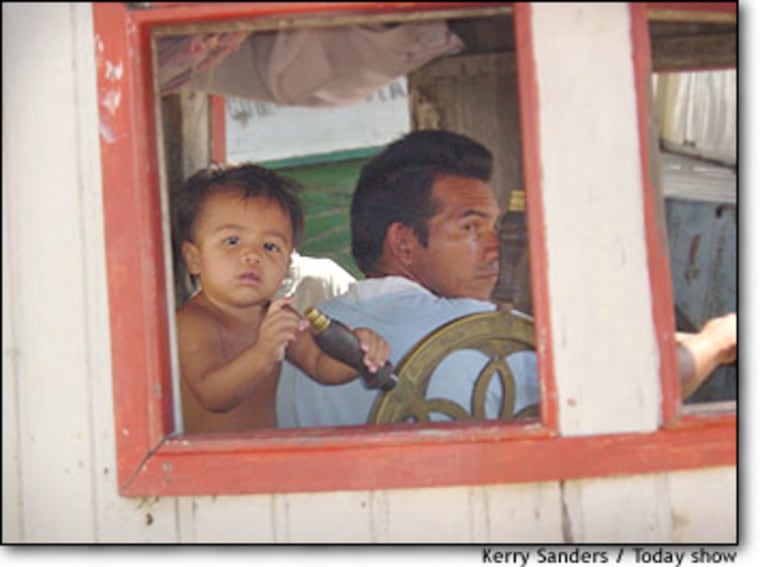When Americans think of the vast South American country of Brazil, along with the girl from Ipenema, the beaches and the samba, it’s the Amazon that holds a vast treasure trove of mystery, natural beauty and fascinating culture. “Today” sent NBC’s intrepid Kerry Sanders deep into the heart of the Amazon basin to tell us more. He shares his report below.
THE AMAZON
Here in Brazil this unique rain forest is larger than New York, California, Utah and Tennessee combined. A vast jungle that’s home to wildlife and plants still to be discovered. There are monkey’s of all shapes and sizes here, birds boasting with color and magical pink dolphin, playful when a group of children feed them pieces of cut bait. And of course, there are the Brazilians who call these riverbanks home.
Our journey takes us far from the cities. Here, an estimated 125,000 — including native Indians — live in the largest fresh water Archipelago in the world.
Guiding us through this untamed region is Luiz Magalhaes. Born and raised here, Luiz learned English from American missionaries.
There are two major rivers in the rain forest here — the Amazon and the Rio-Negro. The meeting or the rivers is unique. Because of the different pH levels in the water, the rivers collide the way a child might color with crayons — red on one side, black on the other.
At this time of year, the water levels rise 30 feet, but not high enough to hide our first surprise — in the jungle, a white sand beach.
Here, 16 men join as a team, fishing four months of the year. The elder fisherman sits atop a tower. When asked if he actually sees the fish, he says he knows the fish are there because he can see the surface begin to vibrate.
Hours of boredom: now punctuated by excitement. Today’s haul includes flesh-eating piranha. But unlike the Hollywood version, piranhas rarely attack humans, and when they do, it’s when the victim is bleeding and the fish are mating.
In an environment where if you take one wrong turn, Mother Nature can kill you, there is no room for competition amongst men. It’s a theme we saw emerge throughout the rain forest: people working together for survival. The fishermen here share the work, the catch and the money they will earn selling the fish down river. This is a good day they say: each man netting about $4 for 12 hours of work.

Caught this day is a fish unlike any you have ever seen. Locals call it: cuicu. Plated with armor, this pre-historic catfish is not to be played with.
Up river, boat builders are busy constructing a new fishing vessel. It will take 15 months to complete. Otaviano Olivera says his oldest son disappears into the rain forest for a week to find just the right itauba tree — the best boat-building lumber, from 100-year-old trees.
When asked if he hopes his son will someday follow in his footsteps, Olivera says, “No. I don’t want my son to build boats because this is a sad job. I recognize every tree I need is destroying our rain forest.
American tourists who travel here say after they see the monkeys, plants and the unique pink dolphins, they can’t help but notice what the residents here have that we don’t.

“They have a simplicity about their lives that is beautiful. I think we complicate our lives with so much. We complicate our lives with every single thing that comes into it. Technology I suppose is the main destruction for it. And these people don’t have that, and hopefully will never have that,” says one tourist.
Simplicity: like Alejandro shimming up an assaí tree. The Rivero family believes what the Yanomami Indians discovered 250 years ago: the nuts hold unique powers. Stripped from the limbs, they are mixed with boiling water and then mashed. A little help is always welcome.
In the rain forest, the assaí drink is believed to help women after birth, and to give anyone who drinks it a burst of energy. While I feared it might make me sick, manners dictated I had to take a drink. Sebastian Rivero told me one other thing about this drink: It’s Amazon rain forest Viagra. In keeping with the spirit of the people here, Sebastian would not let met leave empty handed.
The Amazon rain forest: sometimes called the lungs of the planet, is unlike any other place on earth.